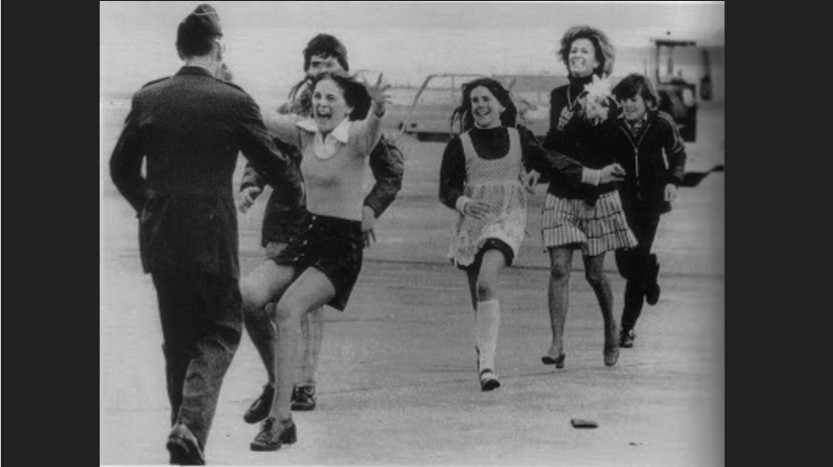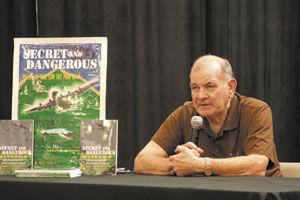Museo de Historia Militar de Hanoi
http://alejandro-8.blogspot.com/2019/01/museo-de-historia-militar-de-hanoi.html
http://alejandro-8.blogspot.com/2019/01/museo-de-historia-militar-de-hanoi.html
Me conmovió esta fotografia,y busqué mas datos....






Gracias por compartirlo Biguá!!!Me conmovió esta fotografia,y busqué mas datos....





Col. Robert Stirm survived six torturous years in Vietnamese prison camps and then had his homecoming immortalized in a 1974 Pulitzer Prize winning photo of his children joyfully greeting him at Travis Air Force Base.
The indelible image captured the heart of America and became one of the most memorable photos of a generation. The photo, Burst of Joy, was captured by Associated Press photographer Slava "Sal” Veder the moment Stirm was reunited with his family six years after being shot down over Hanoi.
His four children display the picture prominently in their homes. Stirm, a San Mateo native and longtime Foster City resident, does not. Three days before arriving at Travis Air Force Base Stirm received a Dear John letter from his wife. The two were divorced within a year.
"I do not display that photo because it did not result in an ideal situation,” Stirm said.
Stirm agreed to recreate the scene more than a decade ago for a television special on Pulitzer Prize winning photos. He did it for his children, Stirm said.
These days, Stirm is more comfortable speaking about his time as a Vietnam prisoner of war. He was on hand to answer questions Saturday at the Hiller Aviation Museum during a presentation of Bill Guenon, an Air Force raider who led a mission into Son Tay to rescue American prisoners of war.
Guenon, a Boston resident, wrote Secret and Dangerous, a book describing the Son Tay raid.
Saturday was a reunion of sorts. Guenon reunited with four other Son Tay raiders who traveled from as far as Texas to be a part of Saturday’s event. Stirm was able to meet one of the many men assigned to rescue him and hundreds of other POWs.
Stirm was shot down over Hanoi, October, 1968. He was 35 years old. He was immediately captured and imprisoned. He spent the next 1,985 days as a POW. He was originally held in the Son Tay prison and was later moved to a prison commonly referred to as the Hanoi Hilton. He survived the six years next to highly trained Air Force officers — lawyers, doctors and scientists.
The hundreds of men in captivity were fed "sauteed sewer greens,” pumpkin soup and ground-up pig remains. They were "sadistically” tortured. At one point, Stirm said he was nearly drawn and quartered. He survived that incident with two dislocated shoulders, he said.
Many of the U.S. soldiers were kept in solitary confinement. They were forced to communicate with each other through a tap code that did not need the "dash” used in Morris Code. The soldiers would signal each other by tapping "Shave and a Hair Cut.” If the double-dash signifying two bits came back, the soldiers were free of enemy ears, Stirm said.
"It sounded like you were in the press room with all the typewriters,” Stirm said. "Every night we’d tap good night and God bless.”
Advanced survival training helped keep Stirm and many of his fellow soldiers alive.
They were all trained to memorize the names of every other imprisoned soldier. Stirm would recite approximately 250 names alphabetically, twice a day, he said.
"You’ve got to keep you mind busy. I tried to recreate my life. I reconstructed my kindergarten class, first grade ... It’s all in your mind,” Stirm said.
Stirm attended San Mateo Park Elementary School and San Mateo High School. Being in the Air Force was always a dream. He could remember watching the planes during WWII roar over San Mateo High as he stood on the roof to observe. Once Stirm graduated San Mateo High, he attended two years at the University of Colorado. He left Colorado as soon as he had the 60 credits necessary to join the Air Force academy, Stirm said.
Stirm also said that as he recounted his school years, he realized there were only two classmates he did not fight.
As an older POW, Stirm felt it necessary to lift the spirits of others. As Stirm saw it, he has already had the chance to marry and have children. There were younger POWs who drove themselves to despair thinking of what they might miss if never rescued. It was Stirm, and others like him, that helped those men survive.
It was his homecoming that helped lift the spirits of an entire nation.
That was something for which Stirm could never have prepared.

PHOTO DETAILS / DOWNLOAD HI-RES 1 of 1
Retired Col. Robert L. Stirm stands in front of the F-105 Thunderchief at Edwards AFB's Century Circle Apr. 5. (U.S. Air Force photo by Laura Mowry)




Siemre me preguntè que le pudo haber quedado en la cabeza a esos pibes.Un niño vietnamita mira a un soldado estadounidense mientras se protegen del fuego de francotiradores de Vietcong, Bao Trai, Vietnam (1966)



